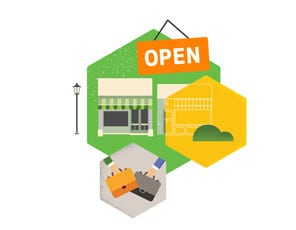How to Access SBA Funding for Your Small Business

About 530,000 people start new businesses in this country every month, according to the 2015 Kauffman Index. And a full half of working adults in the United States either own or want to own their own businesses, according to a 2014 national survey conducted by the University of Phoenix School of Business.
For many of these entrepreneurs, one of the biggest challenges is securing the financing to start or grow their business, as small business lending is considered risky because they have a higher propensity to fail.
That’s where the SBA enters the picture. While the federal agency is not a direct lender of capital, it supports small business development by eliminating some of the risk to lenders by guaranteeing that loans made to small businesses will be repaid. In fiscal year 15, the SBA supported a record-breaking $33 billion in loans to small businesses nationwide, including more than $600 million in the Columbus area.
"That’s a lot capital that would otherwise be parked on the sidelines if not for collaboration between the government and the lenders,” Martin Golden, the SBA’s Columbus district director, said. “And, that capital didn’t just get out the door; it got to the people who need it the most. Our lending is up in every minority group.” Some small business owners use credit cards for financing, borrow from friends and families, or turn to crowdfunding online, too. “You may have several options for sources of capital, including local and state economic development organizations, venture capital or angel investors,” said Margaret Ference, senior vice president and SBA group manager at Huntington Bank. “It’s important to know all of the details before you seek funding from any source, because each comes with risks and rewards.”
OUR GOAL IS TO HELP YOU GROW YOUR BUSINESS. LEARN MORE.
There are some clear advantages to SBA-backed loans made through a bank or other certified lender. SBA loans are regulated and offer better terms with relatively low down payment requirements, little to no fees and longer terms (up to 25 years). This contributes to lower monthly payments, which means the business owner has more working capital for other business expenses. And, because the SBA guarantees up to 75 percent of the debt, small businesses are much more likely to qualify for an SBA-backed loan than a traditional loan.
The 7(a) loan is the SBA’s largest and most popular loan program; it’s designed for eligible borrowers who want to open, acquire or expand a small business.
Becoming Application Ready
Accessing SBA-backed financing for your small business requires sound personal financial health and “a very keen understanding of your company’s financial needs, both in the near term and in the future,” Ference said.
It also requires careful preparation. According to Small Business Trends, one of the most common reasons small business loan applications are denied is a lack of preparation.
A benefit of working with the SBA is that it has several resource partners available to guide you through putting all of this information together for your business. “Whether it’s a business plan, updated financials or industry insight, our SCORE chapters and Small Business Development Centers are ready to assist,” Golden added. “The free and low-cost advising they offer, along with our website’s online courses and dedicated women and veteran centers, can make sure you are properly prepared.”
Before you meet with a banker, Ference said, “It is critical that you have a clearly defined business plan that outlines how your operations and financial position align with your goals and objectives. Think of this as your company’s roadmap. Your business plan reveals the route you’ll take to grow your company’s revenues.” Typically, a business plan will include projections for three to five years.
The plan is your chance to communicate your business story, she said. “What is your value proposition? What differentiates you from others?”
The SBA website provides an online Business Plan Tool, with step-by-step instructions for putting your plan together, as well as a checklist of all the other documents you’ll need if you apply for an SBA 7(a) loan.
TAKE A LOOK AT SOME OF OUR SBA LOAN PROGRAMS.
Meeting with a Banker
“Before you make a loan application, I suggest asking your banker questions that will help you understand how the bank makes lending decisions,” Ference said. “What are the bank’s key factors in determining whether or not your loan is approved?”
Be sure to ask how the lender will flex and grow with your company, she said. “As your company grows, your business needs will evolve. Cash flow is one of the biggest challenges for most small business owners; ask how the bank can help you manage your cash flow efficiently.”
At Huntington, Ference and her team of SBA lending experts discuss these questions with small business owners every day as they guide potential borrowers through the SBA loan application process.
“Essentially, we look for solid forecasts,” Ference said. “How do potential small business owners plan to build their business? What kind of a resume do they have? Do they have strong people around them to help them build the business?”
On these pages are success stories of several first-time small business owners, all of whom got started with the help of SBA-backed financing.
“These stories further illustrate the entrepreneurial passion and vision that is alive and well throughout Ohio,” Golden said. “The SBA will continue to be advocates for entrepreneurs and small business – whether they’re just starting out, looking for financing, looking for new customers, or want to get to the next level – so we can continue to create opportunity in our local communities.”
